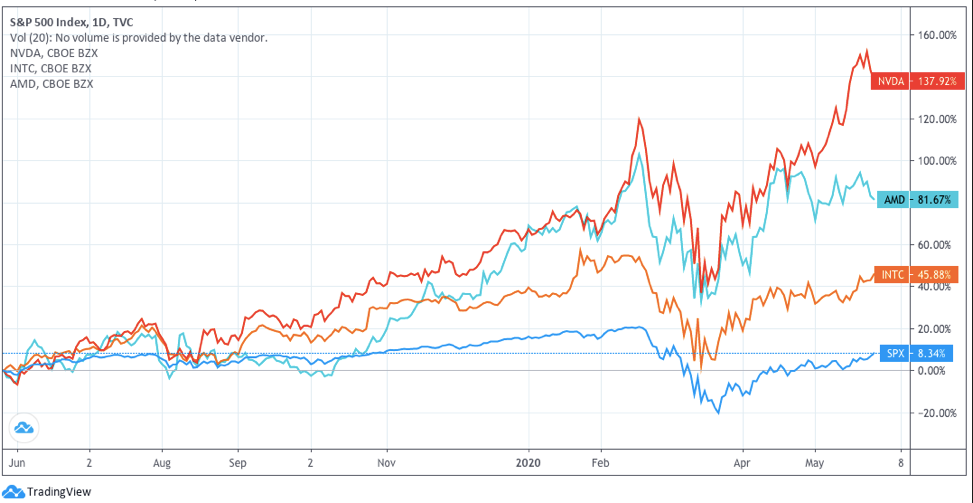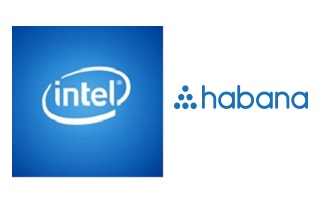eResearch | The semiconductor industry was mildly affected by the pandemic as most chip makers experienced increased revenue growth in Q1/2020, with expectations for continued demand for processors and cloud services as more companies adapt to remote work environments.
In the U.S., while chip makers expand rapidly, the Donald Trump administration has continued to target Huawei, the Chinese phone manufacturer, with new amendments that force any chip maker using U.S. technologies to end supply deals with Huawei.
See below for highlights on Q1/2020 earnings for Advanced Micro Devices (NASDAQ: AMD), Intel (NASDAQ: INTC), and NVIDIA Corp. (NASDAQ: NVDA), as well as further details regarding Huawei Technologies Co., Ltd.
Advanced Micro Devices
 Last month, Advanced Micro Devices (NASDAQ: AMD) announced Q1/2020 financials with revenues of US$1.8 billion, a 40% increase year-over-year, and net profits of US$162 million, a 913% increase year-over-year. For Q2/2020, AMD forecasts revenue of approximately US$1.85 billion.
Last month, Advanced Micro Devices (NASDAQ: AMD) announced Q1/2020 financials with revenues of US$1.8 billion, a 40% increase year-over-year, and net profits of US$162 million, a 913% increase year-over-year. For Q2/2020, AMD forecasts revenue of approximately US$1.85 billion.
In Q1/2020, AMD experienced significant growth due to developing smaller processor chips, which attracted numerous clients from companies focused on data servers to companies developing machine learning technologies.
AMD’s current generation EPYC server chips are based on a 7-nanometer node, half the size of competitors such as Intel. The smaller chips allow AMD to pack transistors closely together to maintain high performance capabilities while keeping heat generation and costs down.
Lenovo, a China-based technology company, recently launched a new server that includes two of AMD’s EPYC server chips, which increased power for high-performance virtualized environments by up to 35%, according to the Lenovo Data Centre Group.
In addition, NVIDIA recently announced a switch to using EPYC chips for the newest model of its end-to-end machine learning A.I. system, after using Intel’s processors for the previous two models.
AMD plans to launch improved processor chips based on a 5-nanometer structure by 2020, while Intel plays catch-up with a 10-nanometer chip expected to launch this year.
To support the ongoing pandemic, AMD recently announced a COVID-19 fund to provide research institutions with the appropriate technology, including the donation of US$15 million worth of high-performance systems with EPYC chips.
Intel
 Last month, Intel (NASDAQ: INTC) announced Q1/2020 financials with revenues of US$19.8 billion, a 23% increase year-over-year, and net profits of US$5.7 billion, a 42% increase year-over-year. For Q2/2020, Intel forecasts revenues of US$18.5 billion.
Last month, Intel (NASDAQ: INTC) announced Q1/2020 financials with revenues of US$19.8 billion, a 23% increase year-over-year, and net profits of US$5.7 billion, a 42% increase year-over-year. For Q2/2020, Intel forecasts revenues of US$18.5 billion.
In Q1/2020, Intel’s growth was mainly driven by a 43% increase in sales from its Data Center Group, which currently accounts for 71% of total revenues.
The Data Center Group includes sales of Intel’s processor chips for cloud servers, with expectations to start shipping its newly developed chips based on a 10-nanometer node by the end of this year.
Aside from chips, Intel is also focused on the mobility and autonomous driving markets. This month, Intel announced a US$900 million acquisition of Moovit, a mobility-as-a-service provider who provides information to users on various options for transportation services in urban areas.
Intel plans to become a comprehensive mobility provider by synergizing Moovit with its subsidiary Mobileye, a company focused on developing vision-based systems for autonomous driving, which Intel acquired three years ago for US$15 billion.
A significant catalyst Intel is currently working on is a partnership with the U.S. Department of Defense for improving domestic supply chains for technologies related to microelectronics, as the Trump Administration looks to build chip factories in the U.S.
In light of the pandemic, Intel raised US$10 billion in debt and suspended share buyback programs, in an effort to strengthen its balance sheet.
NVIDIA
 This month, NVIDIA Corp. (NASDAQ: NVDA) announced fiscal Q1/2020 financials with revenues of US$3.1 billion, a 39% increase year-over-year, and net profits of US$917 million, a 133% increase year-over-year. For FQ2/2020, NVIDIA forecasts revenues of US$3.7 billion.
This month, NVIDIA Corp. (NASDAQ: NVDA) announced fiscal Q1/2020 financials with revenues of US$3.1 billion, a 39% increase year-over-year, and net profits of US$917 million, a 133% increase year-over-year. For FQ2/2020, NVIDIA forecasts revenues of US$3.7 billion.
In FQ1/2020, NVIDIA experienced significant growth from its data center business, which reached sales of US$1.1 billion, an 80% increase year-over-year, accounting for 37% of total revenues.
NVIDIA’s main GPU business for the gaming industry reached US$1.3 billion in revenue, a 27% increase year-over-year. NVIDIA’s GeForce Now cloud gaming service added 2 million users since going live early this year.
This week, NVIDIA announced plans to acquire Cumulus Networks, a provider of open-source software developed to support enterprise customers to optimize data center networking stacks.
Prior to the announcement, Cumulus Networks was already in partnership with Mellanox Technologies, a supplier of computer networking products used to connect chips to data centers, which was acquired by NVIDIA for US$7 billion with the deal having closed this week.
To support employees during the pandemic, NVIDIA pushed forward payroll raises by six months. In addition, NVIDIA’s employees have taken an active movement in donating US$10 million towards the fight against COVID-19.
U.S. Cuts Huawei’s Semiconductor Supply Chain
 Last week, Huawei took another hit from the U.S. Commerce Department with an amended export rule, which blocks the shipment of semiconductors to Huawei from foreign manufacturers who use software and technology of certain U.S. companies.
Last week, Huawei took another hit from the U.S. Commerce Department with an amended export rule, which blocks the shipment of semiconductors to Huawei from foreign manufacturers who use software and technology of certain U.S. companies.
The amendment will prevent semiconductor manufacturers such as Taiwan Semiconductor Manufacturing Co. (TPE: 2330) from supplying needed parts for Huawei’s HiSilicon processing chips, which recently became the market leader for sales in China.
Huawei is one of the world’s largest phone manufacturers. However, its products have barely penetrated the U.S. market due to concerns regarding national security and intellectual property infringement.
In 2012, the U.S. banned companies from using Huawei’s networking equipment, and last year, U.S. President Donald Trump enacted an executive order, banning Huawei from U.S. communication networks.
Nevertheless, Huawei continues to lead the global smartphone market as the second largest manufacturer, only behind Samsung Electronics Co. Ltd. (KPX: 005930) in sales.
CHART 1: S&P 500 vs AMD, INTC, and NVDA, 1-Year Stock Performance




